Converting to Xeriscape
Did you know that 60-70% of your water bill could be from outdoor water use? Here in the desert, we receive about 7 inches of rainfall in an average year. With such little rainfall, it makes sense to have a landscape with low water use plants.
Converting grass to low water use landscaping has many benefits:
| • | Reduces water bills |
| • | Cuts fertilization costs |
| • | Reduces maintenance |
| • | Minimizes green waste going to landfills |
| • | Attracts native wildlife (hummingbirds, butterflies, etc.) |
| • | Brings many colors, textures, and interest to your yard |
| • | Increases your home value |
 Photographer: Kathleen Moore |
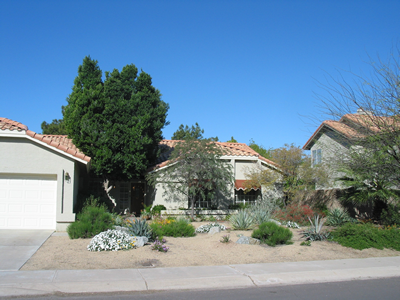 Photographer: Kathleen Moore |
Now that you are ready to convert, follow these simple steps to ensure your conversion is a success.
Step 1 Evaluate Your Site
Sketch your lot showing property lines and dimensions. Determine sun exposures. Observe how water flows on your property when it rains. Identify slopes, overflow drainage, and any existing low spots. You do not want water pooling near your foundation, but you may want to grade your landscape to direct rainwater to planting areas and trees.
Take an inventory of your current plants, materials, and the irrigation system. Indicate on your sketch the plants you want to keep. Determine if there are on-site resources that can be used, such as old bricks or concrete. Will your irrigation system easily convert or are you going to abandon it and start over? You may need an irrigation specialist to evaluate your system.
Before digging be sure to call the Blue Stake Center (1-800-STAKE-IT) to have them identify your utility lines.
More detailed information on landscape design can be found in Xeriscape – Landscaping with Style in the Arizona Desert.

Step 2 Plan Your Design
Once you have done a complete site analysis, you are ready to begin your design. Begin with the location and placement of the hardscape elements such as patios, seating walls, pathways, etc.

Photographer: Kathleen Moore
Plan your large hardscape elements like patios and arbors first.
Indicate any contours and grading changes (see Rainwater Harvesting). Always remember to plan for overflow drainage. Next think about your plant groupings. Place trees to maximize shade for buildings, people, and other plants. Remember to group plants with like irrigation needs. Think about the function of plants in your landscape. Look at the database on this CD to assist you in choosing the plants for your space. Be sure to pay attention to mature size, amount of leaf litter and blooming time. It is nice to balance out seasonal bloomers so you have color in your yard all year.
Step 3 Remove Your Turf
The key to any successful conversion is to completely remove and or kill the grass and weeds in the area you want to convert. This will take some persistence. For best results, apply a post-emergent on the Bermuda grass when it is actively growing in the months of May through September. Make sure your lawn has been properly irrigated and is a vigorous green. Do not mow one week before applying the post-emergent. Apply a contact herbicide containing the chemical glyphosate. Glyphosate is sold under, but not limited to, the trade names of ROUNDUP, DOOMSDAY, or KLEENUP.
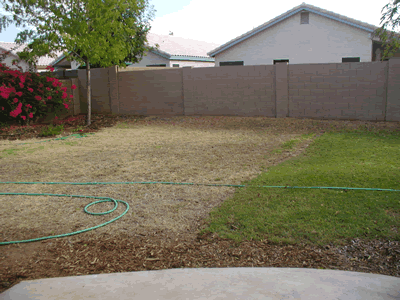
Photographer: Jake Kupiek
Grass two weeks after being sprayed with ROUNDUP.
Water and fertilize the grass and apply a second application about two weeks later. It is best to spray in the morning when the plant absorbs the glyphosate quickly. Once your landscape is installed, you will need to follow up once a month and spot treat any small areas of regrowth for about a year.
Once the grass is dead, you can either:
| 1. | Scalp the grass close to the ground |
| 2. | Rent and use a rototiller (best done when the ground is moist) |
| 3. | Rent a sod cutter or bobcat to remove the top 3-4 inches of grass and soil |
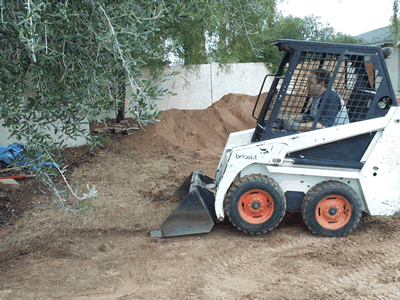
Photographer: Kathleen Moore
You can use a Bobcat to remove the sod.
If you are going to use the sod cutter or bobcat, consider taking the cut pieces of grass and flipping them upside down (root side up) and placing them where you want your mounds to be.
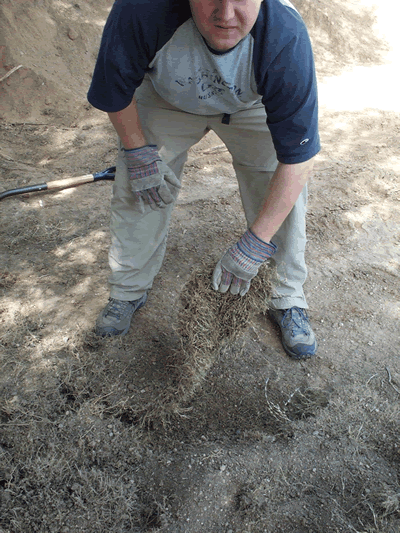
Photographer: Kathleen Moore
After cutting sod, the pieces are flipped over.
Step 4 Grade Your Landscape
Think about creating contours in your landscape. Contours not only add interest to your landscape, but they can keep as much rain water on your property and near your plants’ roots as possible. This not only saves on your water bill, but it keeps water off the streets and out of the storm drains. The supplemental rain water will make your plants healthier and more resistant to drought conditions.
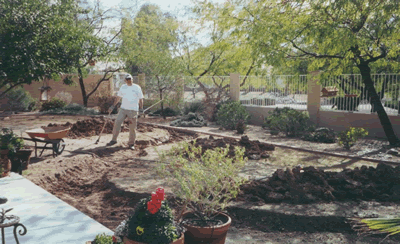
Photographer: Debbie Schauer
Hardscape features, like a patio, must be installed properly to allow for drainage. If you have any black plastic under existing granite areas, now is the time to remove it. Black plastic does not allow for rainwater to reach your plants’ roots and it can actually damage plant roots. It does not stop weed seeds from germinating because over time a layer of dirt forms on top of the plastic.
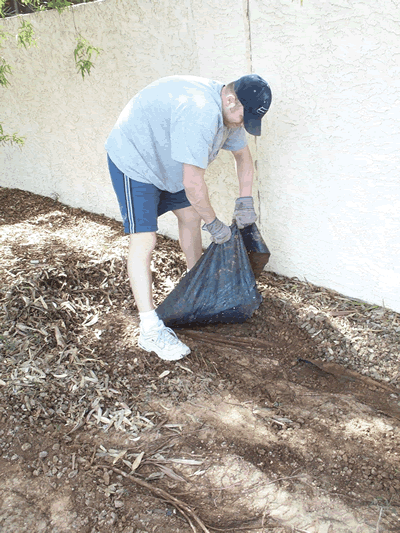
Photographer: Kathleen Moore
Black plastic should be removed.
Step 5 Renovate Your Irrigation System
Plan your irrigation system before you install any plants. It is best to consult an irrigation specialist to assist you with the design of your system. A great resource guide is called Landscape Watering By the Numbers. You can download a copy of this guide at www.wateruseitwisely.com. If you are not sure where your irrigation lines are located, or your system is old, you may need to abandon your old system and install new irrigation lines.
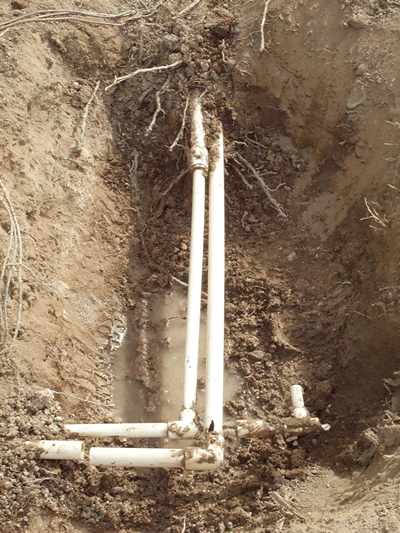
Photographer: Kathleen Moore
This system is old and needs to be abandoned.
Whether you install new or retrofit your system, keep these points in mind:
| 1. | Trees should be on a separate valve than shrubs and groundcovers because of different water requirements. |
| 2. | If you are installing hardscape, be sure to install a 1-inch PVC pipe under the concrete. This will serve as an access sleeve for your irrigation system. |
| 3. | Take a photo or make a map with measurements as you install your new system so you can locate pipes later in case of new plantings or repairs. |
Step 6 Install Your Plants
Ideally, most plants should be installed in the fall to give them as much time as possible to establish themselves before summer begins. Frost-sensitive plants such as bougainvillea and lantana are best planted in the spring.

Photographer: Kathleen Moore
Step 7 Select Your Mulch
Mulches come in organic (bark chips, compost, leaf litter) and inorganic (decomposed granite, river rock) forms. Organic mulches work best in small areas such as planting beds. They do a better job of maintaining soil moisture and adding nutrients to the soil. You will need to regularly add organic mulches as they do decompose over time. Inorganic mulches control dust, keep the soil moist, and can be more permanent. Granite comes in myriad colors and sizes. Check with your local rock dealer for more information on the differences between them. Do not place plastic or landscape cloth between the ground and your mulch. They will not stop weeds from sprouting and over time can deteriorate and come to the surface.
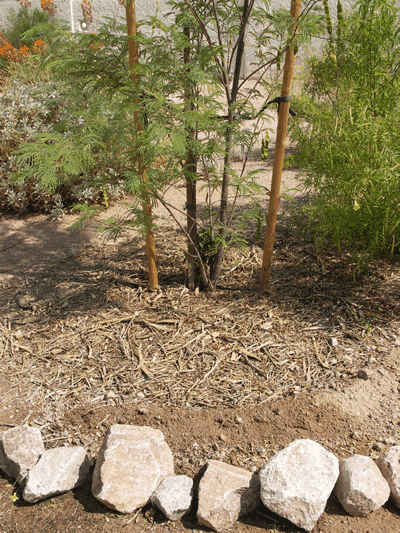
Photographer: Kathleen Moore
Shredded bark can be used as an organic mulch around the base of plants.
Step 8 Maintain Your Xeriscape
Xeriscapes do require less maintenance than a traditional grass landscape, but they are not completely maintenance free. Your irrigation system will need to be adjusted seasonally to accommodate your plants’ water needs. In general, plants will need light to moderate pruning once or twice a year. Applying a pre-emergent herbicide twice a year will help keep weeds down.
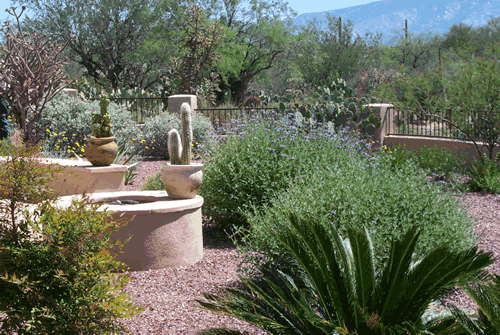
Photographer: Christina Bickelmann
A beautifully maintained xeriscape landscape.
Kathleen Moore
Water Conservation Coordinator
City of Chandler